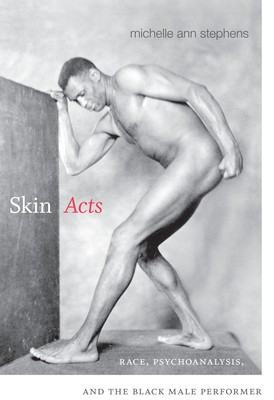
- We will send in 10–14 business days.
- Author: Michelle Ann Stephens
- Publisher: Duke University Press
- ISBN-10: 0822356686
- ISBN-13: 9780822356684
- Format: 15.8 x 23.4 x 2.3 cm, hardcover
- Language: English
- SAVE -10% with code: EXTRA
Reviews
Description
In Skin Acts, Michelle Ann Stephens explores the work of four iconic twentieth-century black male performers--Bert Williams, Paul Robeson, Harry Belafonte, and Bob Marley--to reveal how racial and sexual difference is both marked by and experienced in the skin. She situates each figure within his cultural moment, examining his performance in the context of contemporary race relations and visual regimes. Drawing on Lacanian psychoanalysis and performance theory, Stephens contends that while black skin is subject to what Frantz Fanon called the epidermalizing and hardening effects of the gaze, it is in the flesh that other--intersubjective, pre-discursive, and sensuous--forms of knowing take place between artist and audience. Analyzing a wide range of visual, musical, and textual sources, Stephens shows that black subjectivity and performativity are structured by the tension between skin and flesh, sight and touch, difference and sameness.
EXTRA 10 % discount with code: EXTRA
The promotion ends in 17d.10:45:10
The discount code is valid when purchasing from 10 €. Discounts do not stack.
- Author: Michelle Ann Stephens
- Publisher: Duke University Press
- ISBN-10: 0822356686
- ISBN-13: 9780822356684
- Format: 15.8 x 23.4 x 2.3 cm, hardcover
- Language: English English
In Skin Acts, Michelle Ann Stephens explores the work of four iconic twentieth-century black male performers--Bert Williams, Paul Robeson, Harry Belafonte, and Bob Marley--to reveal how racial and sexual difference is both marked by and experienced in the skin. She situates each figure within his cultural moment, examining his performance in the context of contemporary race relations and visual regimes. Drawing on Lacanian psychoanalysis and performance theory, Stephens contends that while black skin is subject to what Frantz Fanon called the epidermalizing and hardening effects of the gaze, it is in the flesh that other--intersubjective, pre-discursive, and sensuous--forms of knowing take place between artist and audience. Analyzing a wide range of visual, musical, and textual sources, Stephens shows that black subjectivity and performativity are structured by the tension between skin and flesh, sight and touch, difference and sameness.


Reviews